Press release 2014-09-11 at 13:36
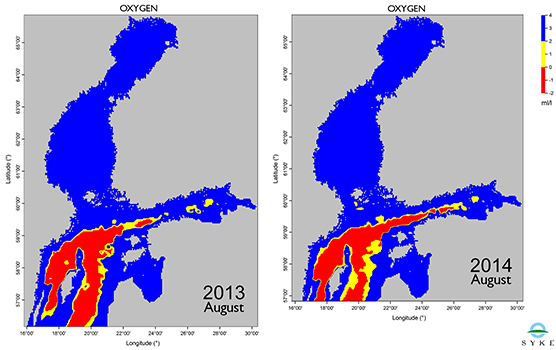
Oxygen levels close to the sea floor in the Baltic Sea in August 2013 and 2014.
The oxygen situation of the southern and central parts of the Baltic proper have improved, but the oxygen situation on the deep open-sea floors of the Gulf of Finland have continued to deteriorate since the early summer. The results were obtained by the research vessel Aranda in August. The observations by the research vessel in the Gulf of Finland reveal that the algae levels have decreased further in the eastern part of Finland’s sea areas.
The observations of Aranda in the Baltic proper support the observations released by the Leibniz Institute for Baltic Sea Research (IOW) in August, stating that for the first time since 2003, large amounts of moderately salty and oxygen-rich water had flown with the west winds to the southern parts of the Baltic Sea, all the way to the Gotland basin, in February and March. This has improved the oxygen situation in the southern and central parts of the Baltic Sea, but its influence has not yet reached the northern parts of Baltic proper or the Gulf of Finland. However, the long-term deterioration of the oxygen situation in the Baltic proper has come to a halt. The situation will be monitored during the expeditions of Aranda in the autumn and winter.
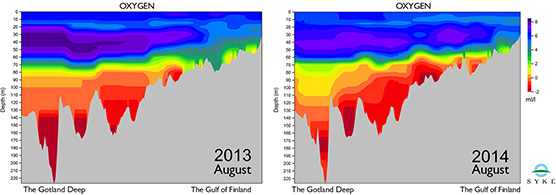
Oxygen levels from Gotland to the Gulf of Finland in August 2013-2014.
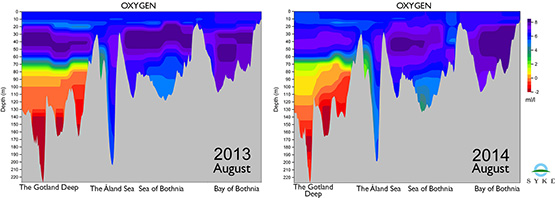
Oxygen levels from Gotland to the Bothnian Bay in 2013 and 2014.
The measurements conducted by Aranda at the end of August reveal that the phosphorus content of the Gotland basin has reduced considerably and the hydrogen sulphide concentration has lowered. However, the volume of the hydrogen sulphide-rich water in the basins of the central Baltic Sea is not necessarily substantial enough to prevent the inflow of salty water from oxidising the entire deep water body of the Baltic proper. However, even a short-term improvement of the oxygen situation can lower the so-called internal phosphorous load and facilitate the reproduction of e.g. the cod in the southern Baltic Sea.
The oxygen situation on deep open-sea floors has deteriorated, no significant changes in the status of the Gulf of Bothnia
The oxygen situation on deep-sea floors in the Gulf of Finland continued to deteriorate from the early summer. The development is due to the flows between the Gulf of Finland and the northern Baltic Sea. On the surface, the water has flown from the Gulf of Finland outwards, whereas low-oxygen, salty water has flown in from the Baltic proper on the sea floor. The oxygen situation might deteriorate further, if the amount and salinity of the water inflow from the North Sea to the Baltic Sea are high enough to push the old, low-oxygen, phosphorous-rich water from the northern parts of Baltic proper to the Gulf of Finland.
The expedition in August revealed that the oxygen had depleted in the water close to the sea floor almost entirely throughout the Gulf of Finland. Hydrogen sulphide amounts were high in deep areas of over 70 metres below sea level. Furthermore, in August, the phosphate phosphorus content was the highest it has been in ten years in the deep areas of the western and central Gulf of Finland.
Based on the results of Aranda, there are no significant changes in the oxygen content or nutrient amount in the Gulf of Bothnia. However, the oxygen content in the Bothnian Sea was slightly lower compared to the previous year.
The algae levels in the eastern part of the Gulf of Finland are the lowest they have been in the 2000s
The oxygen situation was, mainly, good at the observation points of Muikku in the inner and outer archipelagos of the Gulf of Finland. The status of the sea floors and benthic fauna remained, mainly, the same as in the three previous years. The sea floors were in bad condition in the inner archipelago, in areas where horizontal water exchange is low, and in the deepest areas of the outer archipelago that are occasionally affected by the deep current of low-oxygen water from the Baltic proper.
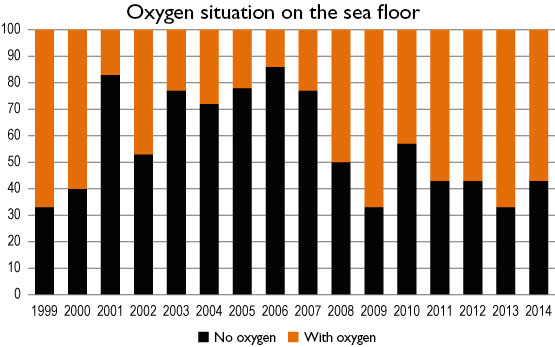
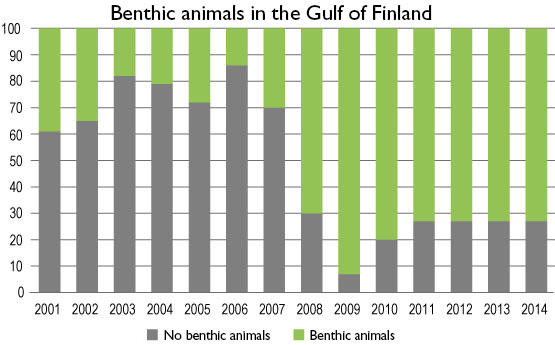
The oxygen situation on the sea floors of the southern parts of the Archipelago Sea is good and the sea floors and benthic fauna are healthy. The situation was worse in certain parts of the inner archipelago. The chlorophyll-a content that represents the algae levels was clearly lower in the eastern Gulf of Finland, compared to the previous year; however, the content had increased from the previous year in the western Gulf of Finland and the Archipelago Sea. The average chlorophyll figures from July and August were the lowest they have been in the 2000s at the easternmost observation points of the Gulf of Finland. The algae levels were at their peak a decade ago, when the state of sea floor was bad in large areas and the internal phosphorous load was high.
The status of the sea floors improved since that, but no particular change has happened anymore in recent years. The external phosphorous load of the eastern Gulf of Finland has reduced significantly after the mid 2000’s. Since 2012, the annual phosphorous load of the Gulf of Finland has been up to 3,000 tonnes lower than ten years ago. This is due to the notable decrease in the discharge of wastewater from the City of St. Petersburg and the effluent from the phosphogypsum stack of the Fosforit fertilizer plant into the river Luga. Based on model estimations alone, a decrease of this scale is expected to show in the algae levels of the sea area, especially as a reduction of the blue-green algal blooms in summer.
A comprehensive overview of the algae levels and nutrient situation in the entire Gulf of Finland in August 2014 – including the Russian and Estonian waters – will be available in October, when an analysis, based on the combined monitoring data of the three countries, is released.
Although the observations in the eastern Gulf of Finland were positive this summer, the improvement might not continue. The oxygen situation and phosphorus content are influenced by the occasional flow of deep water from the Baltic proper to the eastern parts of the Gulf of Finland. When the phosphorus that is released from the low-oxygen deep water mixes with the surface water, considerable eutrophication can temporarily take place, as was the case in the south-eastern sea areas of Finland earlier this summer.
A detailed analysis of the entire Gulf of Finland
In August, Aranda participated in the joint, comprehensive monitoring of the Gulf of Finland, carried out by the three countries during the Gulf of Finland year. This physical, chemical and biological monitoring of the situation comprised around 100 measurement points. The joint, simultaneous follow-up study between Finland, Estonia and Russia was organised for the first time in August 2014. Each country used their own research vessels. The results will provide a comprehensive overview of the current situation of the Gulf of Finland. The results will be published in October.
More information:
Aranda
Leader of the cruise, Senior Research Scientist Maiju Lehtiniemi
Finnish Environment Institute
firstname.lastname@ymparisto.fi
Tel. +358 40 7255 085
Muikku
Leader of the cruise, Senior Research Scientist Seppo Knuuttila
Finnish Environment Institute
firstname.lastname@ymparisto.fi
Tel. +358 40 7609 232
Saltpulses, the Gulf of the Finland Year
Project coordinator, Leading Researcher Kaj Myrberg
firstname.lastname@ymparisto.fi
Tel. +358 295 251 441
Communication
Communication specialist Aira Saloniemi, SYKE Communications
firstname.lastname@ymparisto.fi
Tel. +358 400 1488 75
Photos for media
Oxygen levels close to the sea floor in the Baltic Sea in August 2013 and 2014. (1800 px)
Oxygen levels from Gotland to the Gulf of Finland in 2013 and 2014. (1945 px)
Oxygen levels from Gotland to the Bothnian Bay in 2013 and 2014. (1945 px)